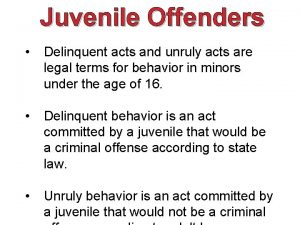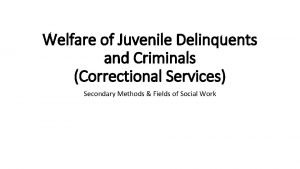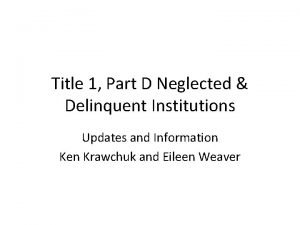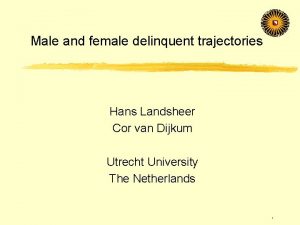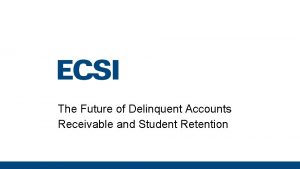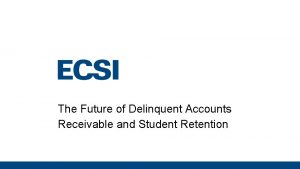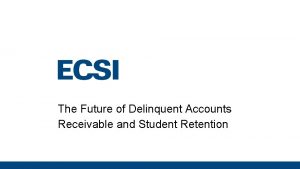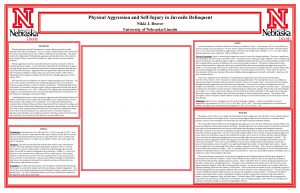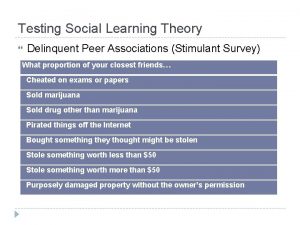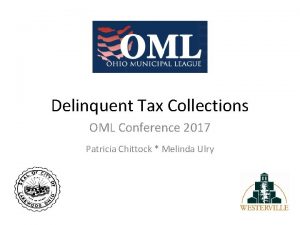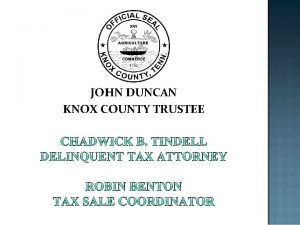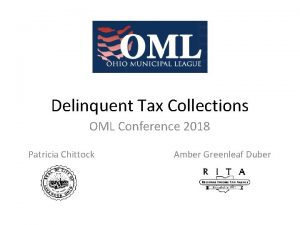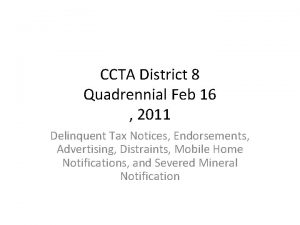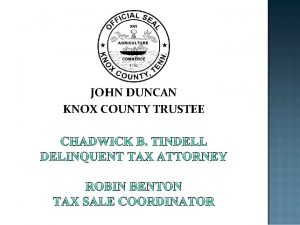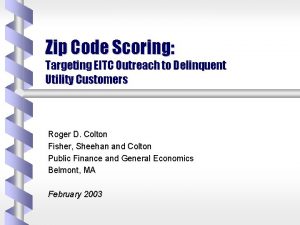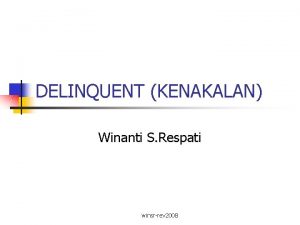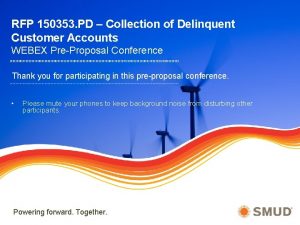Neglected and Delinquent Programming Preparing for Monitoring and














































- Slides: 46

Neglected and Delinquent Programming: Preparing for Monitoring and Conducting Facility Monitoring ESSA Directors Institute Federal Programs and Oversight Erin Christian, Jackie Jacobson | Non-traditional Educational Programs | August 2019

Introductions

Consultants by Region Erin Christian: Northwest, Southwest, and Davidson Dan Froemel: Southeast, East TN, and First TN Jackie Jacobson: Mid Cumberland, South Central, and Upper Cumberland 3

Agenda

Agenda § Introductions § Activity § Year in Review – Demographics – Common Findings § Trends in CSPR Data § Monitoring – What to Expect § Monitoring Facilities § Activity § Review 5

Objectives

Objectives § By the end of this session, participants will be able to: – – – review 2018 -19 data. identify common trends in CSPR data. understand expectations for monitoring. understand how to avoid monitoring compliance concerns. understand expectations for monitoring facilities. 7

Activity

Test Your Knowledge • Play Game 9

Year in Review

Definitions § Institution for neglected children: A public or private residential facility, other than a foster home, that is operated primarily for the care of children and youth who have been committed to the institution or voluntarily places there due to abandonment, neglect, or death of their parents or guardians. 11

Definitions § Institution for delinquent children: A public or private residential facility, other than a foster home, that is operated primarily for the care of children and youth who have been adjudicated by the court to be delinquent or those in need of supervision. 12

Demographics § Number of Districts with a Neglected and/or Delinquent facility receiving Title funds: 35 § Number of Facilities receiving funds for FY 20: 76 13

Neglected and Delinquent Programs, 201819 30 Delinquent Programs 39% 61% 46 Neglected Programs 14

Youth Served in N or D Programs, 2017 -18 15

Funding Allocations § Total allocation of Title I, D – 2018 -19: $1, 475, 791. 30 – 2019 -20: $1, 491, 236. 99 § Total allocation of Title I, A Neglected – 2018 -19: $3, 034, 010. 00 – 2019 -20: $2, 983, 430. 02 16

Trends: CSPR Data 17

Title I-D, subpart 1, CSPR 2017 -18 Highlights: DCS and DOC § For Subpart I, Title ID recipients, 2017 -18 results differed from those for 2016 -17 in the following ways: – DCS average stay increased from 136 days to 172 days (26%). – DOC average length of stay decreased from 238 days to 176 days (-26%). 18

Title I-D, subpart 2, CSPR 2017 -18 Highlights: LEAs § For Subpart 2, Title ID recipients, there were significant changes in demographics and test results as well as other outcomes in 2017 -18: – Average stay increased from 53 to 60 days (by 13. 6%). – Students with disabilities totaled 875, a 25% reduction • Students with disabilities represent 18% of the total population served. 19

Title I-D, subpart 2, CSPR 2017 -18 Highlights: LEAs – The number of Hispanic students grew from 203 to 235 (21%). • 5% of the total population – The number of African American students grew from 2285 to 2416 (5. 7%). • 50% of the total population 20

Title I-D, subpart 2, CSPR 2017 -18 Highlights: LEAs § For Subpart 2, Title ID recipients, there were significant changes in demographics and test results as well as other outcomes in 2017 -18: – Transitional services declined by 11% and pre and post test results declined by 21% in both reading and math. – Yet, within program outcomes increased by 40% and postexit outcomes increased by 25%. 21

Areas of Concern for Title I-D: CSPR Data § There were 4, 831 students served in Title I, D during the 2017 -18 school year. – Transition services were provided for only 1, 612 students. – In-program and out-of-program outcomes: • Within program outcomes totaled 1, 494. • Post-exit outcomes totaled 1, 379. 22

Areas of Concern for Title I-D: CSPR Data § Reading and math outcomes: – Pre-post reading test results were collected for 638 of the 995 long-term students. – Pre-post test math results were collected for 644 of the 995 long-term students. 23

Title I A Neglected CSPR 2017 -18 Highlights § The following demographics were noted: – The total number of students served decreased from 5, 703 to 5, 440 (-5%) – 28% of students are identified as students with disabilities. – 36% of students are considered long-term. 24

Title I A Neglected CSPR 2017 -18 Highlights § Ethnic data: – 64% of students are White. – 28% of students are African American. – 3% of students are Hispanic. § Gender data: – 51% of students are male. – 49% of students are female. 25

Areas of Concern for Title I-A: CSPR Data § There were 5, 440 students served in Title I-A Neglected during the 2017 -18 school year: – Transition services were provided for 4, 115 of the students. – In-program and out-of-program outcomes: • Within program outcomes totaled 1390. • Post-exit outcomes totaled 312. 26

Monitoring

Neglected and Delinquent Facility Monitorings, 2018 -19 § Districts Monitored with Neglected and Delinquent Facilities: 9 – – – – – De. Kalb County: 11/13/18 Montgomery County: 11/14/18 Wilson County: 11/15/18 Hamilton County: 2/25/19 Davidson County: 3/25/19 Blount County: 4/22/19 Sevier County: 4/23/19 Greeneville City: 4/24/19 Cleveland City: 5/8/19 28

What to Expect § All programs must be monitored every three years. § If your district is selected for full on-site monitoring, your N&D programs will be included. § If you were not monitored for on-site or stand alone in the past two years, expect to be monitored this year. § The NEP team will help prepare you with a pre-monitoring call. § Technical assistance is available throughout the process. 29

What to Expect § TDOE team members include at least 2 NEP consultants. § The team will visit the facility, but district personnel must also be present. § Districts will be selected by September 1. 30

What to Expect 31

What to Expect 32

What to Expect § Monitoring results will be delivered in a post-monitoring conference call. § Any areas of concern or non-compliance items will require additional documentation to be uploaded to e. Plan. 33

Monitoring Results: 2018 -19 § Noteworthy Practices – – – Diligent implementation Effective communication between facility and district Strong relationships and collaboration Innovative use of funds Continuum of services for transition Impressive organizational tools 34

Monitoring Results: 2018 -19 § Areas of Concern – Collection of post-discharge outcomes – Transition services – District monitoring of facility 35

Post-Discharge Follow Up/Outcomes § Create an interview instrument that is concise and not intrusive. § Designate a staff member to conduct follow-up interview with students. § If the student is unavailable, contact the case worker. § Decide on an appropriate timeline within the 90 -days after exit. § Document all attempts to make contact and/or interview results. § Get permission to conduct follow up. § Research: Do you actually have a policy that prevents the facility from conducting follow-up? 36

Effective Transition § Discuss transition plan with the student prior to release. § Contact the next school or facility prior to release and/or within one week of release. § Facilitate the transfer of records. § Discuss best practices for the student with the next placement. § Collect CSPR post-discharge information within 90 -days of exit. 37

District Monitoring of Facilities

District Responsibilities § Districts are responsible for monitoring neglected and delinquent facilities every three years. § Districts must develop a monitoring instrument and request supporting evidence from the facility to demonstrate compliance. § Districts are required to provide documentation and results of their monitoring as part of the results-based monitoring process. § It is recommended that districts maintain copies of the monitoring results and related documentation for five years. 39

Putting it Together: Activity § Read your assigned monitoring section. § Discuss the suggested elements of a monitoring instrument. § Summarize the intent of the monitoring element and identify possible items and results that can be collected for evidence of compliance. § Report out to the group. 40

Review

Review § Introductions § Activity § Year in Review – Demographics – Common Findings § Trends in CSPR Data § Monitoring – What to Expect § Monitoring Facilities § Activity § Review 42

Contact information Daniel Froemel (First, East, Southeast) Daniel. Froemel@tn. gov (615) 351 -1208 Jackie Jacobson (Mid-Cumberland (except MNPS), Upper Cumberland, South Central) Jackie. Jacobson@tn. gov (615) 390 -4549 Erin Christian (Northwest, Southwest, MNPS, DCS, DOC) Erin. Christian@tn. gov (901) 504 -9627 43

Questions 44

Districts and schools in Tennessee will exemplify excellence and equity such that all students are equipped with the knowledge and skills to successfully embark on their chosen path in life. Excellence | Optimism | Judgment | Courage | Teamwork

FRAUD, WASTE, or ABUSE Citizens and agencies are encouraged to report fraud, waste, or abuse in State and Local government. NOTICE: This agency is a recipient of taxpayer funding. If you observe an agency director or employee engaging in any activity which you consider to be illegal, improper or wasteful, please call the state Comptroller’s toll-free Hotline: 1 -800 -232 -5454 Notifications can also be submitted electronically at: http: //www. comptroller. tn. gov/hotline 46
 Unruly behavior vs delinquent
Unruly behavior vs delinquent 7 delinquent behaviors
7 delinquent behaviors Categories of delinquent youth
Categories of delinquent youth Seven delinquent behaviors
Seven delinquent behaviors Perbedaan linear programming dan integer programming
Perbedaan linear programming dan integer programming Greedy vs dynamic programming
Greedy vs dynamic programming System programming definition
System programming definition Linear vs integer programming
Linear vs integer programming Perbedaan linear programming dan integer programming
Perbedaan linear programming dan integer programming Iso 22301 utbildning
Iso 22301 utbildning Novell typiska drag
Novell typiska drag Nationell inriktning för artificiell intelligens
Nationell inriktning för artificiell intelligens Returpilarna
Returpilarna Shingelfrisyren
Shingelfrisyren En lathund för arbete med kontinuitetshantering
En lathund för arbete med kontinuitetshantering Underlag för särskild löneskatt på pensionskostnader
Underlag för särskild löneskatt på pensionskostnader Vilotidsbok
Vilotidsbok Anatomi organ reproduksi
Anatomi organ reproduksi Förklara densitet för barn
Förklara densitet för barn Datorkunskap för nybörjare
Datorkunskap för nybörjare Stig kerman
Stig kerman Debatt mall
Debatt mall Delegerande ledarstil
Delegerande ledarstil Nyckelkompetenser för livslångt lärande
Nyckelkompetenser för livslångt lärande Påbyggnader för flakfordon
Påbyggnader för flakfordon Lufttryck formel
Lufttryck formel Offentlig förvaltning
Offentlig förvaltning Urban torhamn
Urban torhamn Presentera för publik crossboss
Presentera för publik crossboss Teckenspråk minoritetsspråk argument
Teckenspråk minoritetsspråk argument Plats för toran ark
Plats för toran ark Klassificeringsstruktur för kommunala verksamheter
Klassificeringsstruktur för kommunala verksamheter Luftstrupen för medicinare
Luftstrupen för medicinare Claes martinsson
Claes martinsson Cks
Cks Byggprocessen steg för steg
Byggprocessen steg för steg Bra mat för unga idrottare
Bra mat för unga idrottare Verktyg för automatisering av utbetalningar
Verktyg för automatisering av utbetalningar Rutin för avvikelsehantering
Rutin för avvikelsehantering Smärtskolan kunskap för livet
Smärtskolan kunskap för livet Ministerstyre för och nackdelar
Ministerstyre för och nackdelar Tack för att ni har lyssnat
Tack för att ni har lyssnat Referatmarkering
Referatmarkering Redogör för vad psykologi är
Redogör för vad psykologi är Borstål, egenskaper
Borstål, egenskaper Atmosfr
Atmosfr Borra hål för knoppar
Borra hål för knoppar

